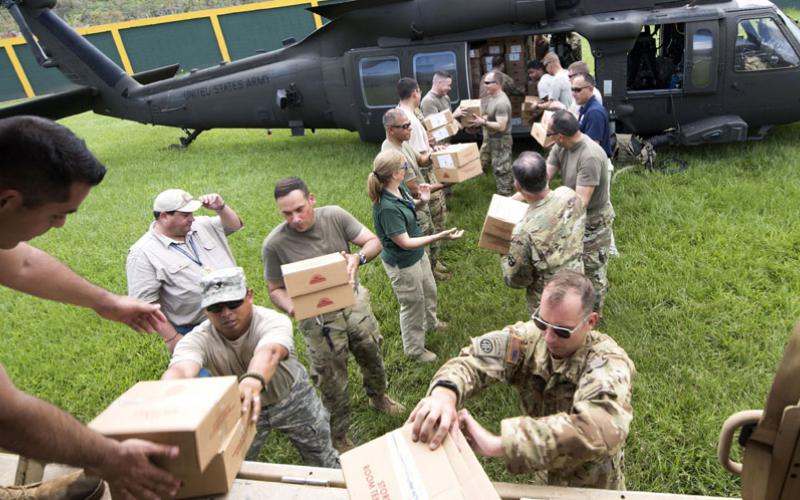SAN JUAN — Some 2,000 miles away from the path of devastation cut by hurricanes Irma and Maria, network engineers at the Rock Island Arsenal Integrated Network Operations Center (INOC) work around-the-clock to support the relief efforts of American aid workers in the U.S. Virgin Islands and Puerto Rico.
Operated by the Army’s product lead for Defense-Wide Transmission Systems, the INOC establishes and supports satellite (SATCOM) communications links for a wide range of missions.
Quality communications channels are the core of any relief effort. Following natural disasters like hurricanes, aid workers often must bring or build temporary communications infrastructure to use in place of battered cellphone towers and toppled telephone lines. Add the complication of coordinating relief on a small island—only 82 square miles, roughly the same size as Des Moines, Iowa—and a dedicated satellite communications link becomes an absolute must.
While hurricanes Irma and Maria crashed through the U.S. Virgin Islands in early September, a U.S. Army Corps of Engineers’ emergency response team rode out the disaster on the tiny island of St. Croix. As the winds calmed, relief teams went to work. Their most valuable assets included a power generation team and a portable satellite terminal.
The portable satellite terminal is a Deployed Tactical Operations System providing network access to approximately 30 persons coordinating relief efforts between Army assets and Federal Emergency Management Agency teams in the area.
“Our deployed teams are composed of individuals with the right expertise from all across the United States, as far away as Portland, Oregon,” explains Sean Higgins, chief for the Army Corps of Engineers Radio Systems Design Branch. “They are supporting efforts like blue roof teams, which provide temporary repairs to make damaged structures habitable again and protect from further rain damage and restoring electrical power to critical infrastructure. Additional service is being provided to our power restoration teams.”
Field service representatives for the Defense-Wide Transmission Systems have configured four additional satellite terminals that are now poised for deployment to the U.S. Virgin Islands and Puerto Rico as the needs of relief efforts dictate.
INOC day-to-day operations center on readiness to respond and support emergent operations. The INOC currently supports nearly 1,000 portable satellite terminals in the field with the Army Sustainment Command, Surface Deployment and Distribution Command, the U.S. Air Force, Army Corps of Engineers and the military medical community. There are nearly 3,800 terminals programmed to use the Defense-Wide Transmission Systems SATCOM network. The INOC is postured to support those terminals immediately when deployed around the world for contingency operations.
This is exactly the type of mission the INOC is designed to support, says Terell Williams, assistant product manager for the INOC. “The INOC’s day-to-day operations are centered around tactical, rapidly deploying satellite communications systems. For example, we are also currently supporting 38 Combat Services Support systems deployed in Florida in response to Hurricane Irma.”
During deployment, physical obstructions prevented the terminal from connecting with the intended satellite. The INOC team worked in conjunction with the USACE team on the ground to quickly redirect the terminal and establish a connection.
The USACE satellite terminals and INOC team keep the lines of off-island communication open 24/7, increasing the efficacy and efficiency of relief efforts.
“It’s always a tremendous feeling to know you are contributing directly to the success of relief efforts, as well with our many other missions,” says Williams. “We’re very lucky in the sense that we get to see the outcome of our direct contribution. It’s very motivating.”




